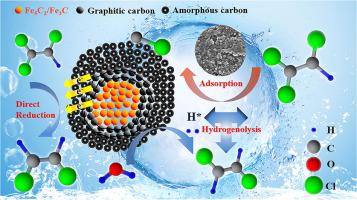Chemical Engineering Journal ( IF 15.1 ) Pub Date : 2020-10-18 , DOI: 10.1016/j.cej.2020.127391 Fanxu Meng , Zhenjie Li , Cheng Lei , Kun Yang , Daohui Lin

|
Nanoscale zero-valent iron (nZVI) is widely studied for environmental remediation in recent years. However, its easy agglomeration, vulnerable oxidation, and runoff limit its practical application. Herein, iron-based lignin-derived biochar composites (Fe-LBC) with different Fe/C ratios were synthesized using a facile carbothermal reduction method and applied for trichloroethene (TCE) removal from anaerobic water. The synthesized Fe-LBC was equipped with higher specific surface area, more uniform nanoparticles distribution, and higher iron carbide content with the decrease of Fe/C ratio from about 1:5 (Fe-LBC5) to 1:30 (Fe-LBC30). TCE removal by Fe-LBC firstly increased as the Fe/C ratio increased from 1:106 to 1:103, and then decreased with the Fe/C ratio further increased to 1:5. The removal efficiency remained largely stable (97.0-98.5%) within the Fe/C ratio range of 1:104-1:30. Fe-LBC30 (1.0 g L-1) could remove 97.4% of TCE (10.4 mg L-1), and owned the highest dechlorination efficiency (30.0%). Iron carbides but not Fe0 could mainly contribute to the dechlorination. The quenching experiment reveals atomic hydrogen (H*) formed under the catalysis of iron carbides, and 1,2-dichloroethene was identified as the main degradation product derived from hydrogenolysis; electrochemical analyses suggest iron carbides could also serve as electron donors to TCE. Moreover, Fe-LBC30 maintained excellent TCE removal efficiency in various water matrixes and pH range of 3-9, revealing its high application potential in practical groundwater remediation. This work firstly demonstrated the reductive dechlorination action of iron carbides rather than nZVI in iron-biochar hybrid materials, boosting our knowledge and potential application of iron-based materials.
中文翻译:

铁基生物炭从厌氧水中去除三氯乙烯:Fe / C比和碳化铁的关键作用
近年来,对零级铁(nZVI)进行了广泛的环境修复研究。然而,其易于团聚,易受氧化和径流限制了其实际应用。在此,使用简便的碳热还原法合成具有不同Fe / C比的铁基木质素生物炭复合材料(Fe-LBC),并将其应用于厌氧水中的三氯乙烯(TCE)去除。随着Fe / C比从约1:5(Fe-LBC 5)降低至1:30(Fe-LBC),合成的Fe-LBC具有更高的比表面积,更均匀的纳米颗粒分布和更高的碳化铁含量。30)。随着Fe / C比从1:10 6增加到1:10 3,Fe-LBC对TCE的去除率首先增加,然后随着Fe / C比的增加而进一步降低至1:5。在Fe / C比为1:10 4 -1:30的范围内,去除效率基本保持稳定(97.0-98.5%)。Fe-LBC 30(1.0 g L -1)可以去除97.4%的TCE(10.4 mg L -1),并具有最高的脱氯效率(30.0%)。碳化铁而不是Fe 0可能主要有助于脱氯。淬火实验表明,在碳化铁的催化下会形成原子氢(H *),并确定1,2-二氯乙烯是氢解的主要降解产物。电化学分析表明,碳化铁还可以作为TCE的电子供体。此外,Fe-LBC 30在各种水基质和3-9的pH范围内均保持出色的TCE去除效率,显示出其在实际地下水修复中的巨大应用潜力。这项工作首先证明了铁-生物炭杂化材料中碳化铁而不是nZVI的还原脱氯作用,从而增进了我们对铁基材料的了解和潜在应用。



























 京公网安备 11010802027423号
京公网安备 11010802027423号